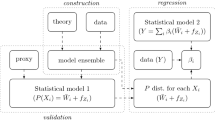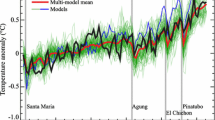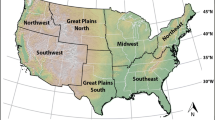Abstract
In climate science, collections of climate model output, usually referred to as ensembles, are commonly used devices to study uncertainty in climate model experiments. The ensemble members may reflect variation in initial conditions, different physics implementations, or even entirely different climate models. However, there is a need to deliver a unified product based on the ensemble members that reflects the information contained in whole of the ensemble. We propose a technique for creating linear combinations of ensemble members where the weights are constructed from estimates of variation and correlation both within and between ensemble members. At the heart of this approach is a Bayesian hierarchical model that allows for estimation of the correlation between ensemble members as well as the study of the impact of uncertainty in the parameter estimates of the hierarchical model on the weights. The approach is demonstrated on an ensemble of regional climate model (RCM) output.






Similar content being viewed by others
References
Berliner LM (2003) Physical-statistical modeling in geophysics. J Geophys Res 108:8776. doi:10.1029/2002JD002865
Cressie NAC (1993) Statistics for spatial data, rev. edn. Wiley, New York
Furrer R, Sain SR (2009) Spam: a sparse matrix R package with emphasis on MCMC methods for Gaussian Markov random fields. J Stat Softw (to appear)
Furrer R, Knutti R, Sain SR, Nychka D, Meehl GA (2007) Spatial patterns of probabilistic temperature change projections from a multivariate Bayesian analysis. Geophys Res Lett 34:L06711. doi:10.1029/2006GL027754
Gilks WR, Richardson S, Spiegelhalter DJ (1996) Introducing Markov chain Monte Carlo. In Markov chain Monte Carlo in practice. Chapman & Hall, London, pp 1–19
Hoeting JA, Madigan D, Raftery AE, Volinsky CT (1999) Bayesian model averaging: a tutorial. Stat Sci 14:382–417
Houghton JT, Ding Y, Griggs DJ, Noguer M, van der Linden PJ, Dai X, Maskell K, Johnson CA (eds) (2001) Climate change 2001: the scientific basis. Contribution of working group I to the third assessment report of the intergovernmental panel on climate change. Cambridge University Press, Cambridge, UK
Kanamitsu M, Ebisuzaki W, Woollen J, Yang S, Hnilo JJ, Fiorino M, Potter GL (2002) NCEP–DOE AMIP–II reanalysis (R-2). Bull Am Meteorol Soc 83:1631–1643
Keller CF (2009) Global warming: a review of this mostly settled issue. Stoch Environ Res Risk Assess 23:643–676
Kim BS, Kim HS, Seoh BH, Kim NW (2007) Impact of climate change on water resources in Yongdam Dam Basin, Korea. Stoch Environ Res Risk Assess 21:355–373
Mardia KV, Kent JT, Bibby JM (1979) Multivariate analysis. Academic Press, San Diego
Neuman SP (2003) Maximum likelihood Bayesian averaging of uncertain model predictions. Stoch Environ Res Risk Assess 17:291–305
Rue H, Held L (2005) Gaussian Markov random fields: theory and application. Chapman & Hall/CRC Press, Boca Raton, FL
Sain SR, Cressie N (2007) A spatial model for multivariate lattice data. J Econom 140:226–259
Sain SR, Furrer R, Cressie N (2008a) Combining ensembles of regional climate model output via a multivariate Markov random field model. Ann Appl Stat (submitted)
Sain SR, Kaufman C, Tebaldi C (2008b) A spatial analysis of a regional climate model experiment. Unpublished manuscript
Solomon S, Qin D, Manning M, Chen Z, Marquis M, Averyt KB, Tignor M, Miller HL (eds) (2007) Climate change 2007: the physical science basis: working Group I contribution to the fourth assessment report of the IPCC. Cambridge University Press, Cambridge, UK and New York, NY, USA
Tebaldi C, Knutti R (2007) The use of the multimodel ensemble in probabilistic climate projections. Philos Trans R Soc A 365:2053–2075
Wackernagel H (2003) Multivariate geostatistics—an introduction with applications, 3rd edn. Springer, Berlin
Ye M, Neuman SP, Meyer PD (2004) Maximum likelihood Bayesian averaging of spatial variability models in unsaturated fractured tuff. Water Resour Res 40:W05113. doi:10.1029/2003WR002557
Acknowledgements
This research of the first author was supported in part by National Science Foundation (NSF) grants ATM-0502977 and ATM-0534173. The second author was supported in part by the NSF grant DMS-0621118. In addition, much of the research in this paper was done while the second author was an assistant professor in the Department of Mathematical and Computer Sciences at the Colorado School of Mines in Golden, CO. We wish to thank the North American Regional Climate Change Assessment Program (NARCCAP) for providing the data used in this paper. NARCCAP is funded by the NSF, the U.S. Department of Energy (DoE), the National Oceanic and Atmospheric Administration (NOAA), and the U.S. Environmental Protection Agency Office of Research and Development (EPA). The National Center for Atmospheric Research is managed by the University Corporation for Atmospheric Research under the sponsorship of the NSF.
Author information
Authors and Affiliations
Corresponding author
Appendix
Appendix
The form for S ϕ = V −1(ϕ) in (4) was assumed to be induced by a type of Markov random field, a spatial statistical model ideal for gridded or lattice type spatial observations (Rue and Held 2005). The essential idea behind such models is the characterization of the spatial dependence through the specification of conditional distributions that link the observation at each spatial location on the lattice to its neighbors. The collection of conditional distributions effectively leads to the specification of the joint precision matrix (inverse covariance matrix) for all of the locations on the grid or lattice.
Assuming Gaussian conditional distributions, these conditional autoregressive (CAR) models are specified through the conditional mean and variance. A very simple specification of the mean and variance are given by
where Y = [y 1,…,y n ], Y −i indicates all of the elements of Y except the ith one, N i denotes a collections of indices representing the neighbors of the ith location on the lattice, and ϕ is a partial or conditional correlation between two neighbors. This collection of conditional distributions can be shown to lead to joint Gaussian distribution with mean \({\varvec{\mu}}=[\mu_1,\ldots,\mu_n]\) and with covariance matrix \({\varvec{\Upsigma}} = \sigma^2({{\mathbf{I}}}_n - \phi{\mathbf {C}})^{-1}\) with I n the n × n identity matrix and C the n × n incidence matrix determined by the neighborhood structures {N i }.
The choice of neighborhoods often plays a crucial role in the behavior of CAR models. For example, in the simple specification in (8), one might simply choose neighbors as grid boxes that share an edge. The version of a Markov random field model used in this work follows a Kronecker form between the precision matrices for two one-dimensional processes, both indexed by the dependence parameter ϕ with one process for the rows and the other for the columns of the output grid for the climate models (see Sain et al. 2008b). Specifically, the conditional means and variances for interior grid boxes are given by
where N 1i and N 2i represents indices for neighboring grid boxes that share an edge or vertices, respectively. (Note that the specification for boundary and corner grid boxes are slightly different; see Sain et al. 2008b, for details.) While this formulation is more complex, the (unconditional) spatial covariance structure is stationary (which the formulation in (8) lacks) and the additional neighbors gives more smoothness to the spatial fields.
Finally, it is important to note that the specification of these models defines the inverse of the covariance matrix, typically referred to as the precision matrix. Furthermore, the precision matrix is generally a sparse matrix. Hence, one can dramatically improve computational performance of the statistical model for large spatial grids, both in terms of the storage of the precision matrix and the linear algebra computations associated with computing the likelihood (see also Furrer and Sain 2009).
Rights and permissions
About this article
Cite this article
Sain, S.R., Furrer, R. Combining climate model output via model correlations. Stoch Environ Res Risk Assess 24, 821–829 (2010). https://doi.org/10.1007/s00477-010-0380-5
Published:
Issue Date:
DOI: https://doi.org/10.1007/s00477-010-0380-5




